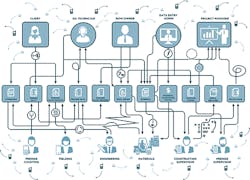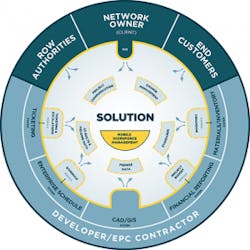4 Best Practices to Get It Right:
As network operators and governments increasingly drive investment dollars into their access fiber infrastructure programs, several characteristics are emerging. Investors are looking for a quicker ROI. In turn, network operators are demanding a compressed delivery cycle and lower price points from their EPC (engineering, procurement and construction) partners. And the EPC vendors are looking for opportunities to reduce the costs and timelines associated with construction. Successfully achieving the objectives of all 3 groups requires the implementation of a well-integrated, GIS-based deployment platform, including aspects related to governance, IT and reporting.
Current Process
Having spent the past 3 years thoroughly involved in managing the deployment of one of the industry’s most aggressive, local access fiber builds, I’ve gained significant insights into how a fully integrated, end-to-end fiber-to-the-premises (FTTP) deployment needs to operate to achieve successful outcomes for the network owner, the EPC vendor, subcontractors, ROW owners, and end users/customers. These learnings are based on overseeing a fully integrated service delivery model, a scope that included: R&D and manufacturing of the materials components; planning and engineering; permitting, procurement and construction; and finally connecting and converting end customers to a GPON network. The pace of the project operated at an average scale of 10K premises passed per month.
4 Scalable Strategies
Strategy 1
Integration of Program Data
You’ll be hard pressed to find a FTTP deployment, at any scale, that does not suffer from data-integrity issues. These challenges begin with the universal issue underpinning most telecom assets: out-dated existing plant and customer premises records. These challenges are further compounded by constant revisions and updates to baseline premises data, evolving standards for new infrastructure, and disconnects between the network owner’s macro-level planning needs and the EPC vendor’s micro-level deployment schedule.
To operate at maximum efficiency and velocity, both the network owner and the EPC vendor need to work off the same set of integrated program data — and this almost always begins with the foundational metric for any local access deployment: premises counts. Premises metrics need to be defined with clarity, and given that they will undoubtedly be adjusted as priorities and serving strategies evolve, this dynamic dataset needs to be shared in real time with both the network owner and the EPC vendor.
Additionally, everyone contributing to the deployment effort needs to have access to an integrated, electronic library of standards. Programs at scale, will likely undergo significant changes to the material and installation standards throughout their lifetime. And given that deployment teams are referencing these standards at various points along a (potentially) multi-year timeline, static document libraries may not be sufficient to manage this dynamism.
Installation crews need to be able to access the standards information relative to the time at which the design records were created. Unfortunately, these may be different from the most current standards upon which new designs are based. In addition, let’s not forget that certain right-of-way (ROW) owners may require unique standards treatments to achieve access to their ROW. Upon commencement of the commissioning process, quality control (QC) inspectors will need to understand the standard against which each element was designed and constructed.
Process Solution
Strategy 2
Integration of Stakeholders
Once the foundation of universal program data has been established, the task of integrating access and distribution of the program data to the various stakeholders begins. A critical concept for any at-scale, outside plant deployment program to embrace, is the fact that the stakeholder group is much broader than the network owner and the EPC vendor. The critical path for these projects will also be greatly influenced by: federal, state/provincial, and municipal governments, ROW owners, and private property owners. The requirements of this diverse stakeholder group need to be addressed not just up front, but on an on-going basis.
Network owners will need to make changes to deployment priorities based on shifting marketing strategies. Municipal and ROW permitting will likely take place in parallel with the deployment. And end-customer requirements (service drops) and concerns (escalations and clean-up) will all have a significant impact on the deployment of construction resources.
The process of submitting designs to the various ROW authorities and the ensuing revisions and approvals process can be a lengthy and frustrating process. Ensuring that all stakeholder requirements are managed and coordinated in a single location will improve the quality of the working relationships among stakeholders and speed the deployment.
Thankfully, many ROW authorities are recognizing the opportunities to generate efficiency and ease of this data translation and are increasingly open to the possibility of managing this correspondence in a common web-based, GIS platform.
Strategy 3
Integrated GIS Equals Better Decision-Making
Laying the groundwork of integrated program data accessed through a common stakeholder delivery platform creates an effective foundation for tracking a complex and diverse data set. However, most teams will struggle to maximize the effectiveness of their decision-making abilities unless they experience the benefit of viewing and understanding this data in a geo-spatial context.
• Network owners want to understand the impact to their program based on regional market dynamics.
• ROW authorities need to plan make-ready programs that reflect the geographic priorities of installation crews.
• Materials management teams need to understand materials requirements by inventory location.
• Construction resources need the ability to target installation tasks that are free of upstream roadblocks.
• Program management teams need the ability to synthesize all this data, on a geo-spatial basis, to ensure an optimized and accurate delivery schedule/forecast.
Strategy 4
Understand and Measure How Scope Moves Through the Program
The culmination of the end-to-end program integration exercise can be found in linking the data and the stakeholders with the contract governance model. If that data is not linked, a disconnect between program governance and the interdependencies of the deployment team can create tension at the senior decision-making level, as the consequences of capital commitments, awards of scope, and obligations to external departments (i.e., marketing and maintenance) generate conflict and produce unintended results.
Responding to changing conditions on the sales and marketing front also has the potential to produce unforeseen delays around the timing of commissioning the network and connecting customers. A change in materials or equipment standards aimed at achieving operational efficiencies might produce unexpected delays at the procurement phase. Both the network owner and the EPC vendor have large teams of resources that need to be optimized and scheduled to achieve operational efficiencies and lower working capital requirements. So, the need to understand the downstream impacts of high-level program decisions is critical to enabling senior level executives to manage these aspects of their business.
A Best Practice Tool
A fully integrated, GIS enabled, deployment platform has the potential to produce and enable many positive outcomes. Of primary importance are the benefits around lowering costs and improving the customer experiences.
First and foremost, the outcome that will produce the largest impact to the bottom line of both the network owner and the EPC vendor, is a reduction in working capital — realized through a reduction in stranded capital, lower inventory levels, and a shorter order to cash cycle. Additionally, increased certainty around deliverables creates a powerful case for the network owner’s capital investment. Finally, an efficient and effortless flow of information between the network owner, the EPC vendor, third-party stakeholders and the end customer, significantly improves the shared stakeholder experiences. These benefits contribute to generating momentum for the broader deployment initiative.
Save
Save
Save
Save







